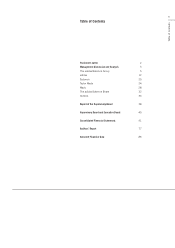Adidas 1999 Annual Report Download - page 15
Download and view the complete annual report
Please find page 15 of the 1999 Adidas annual report below. You can navigate through the pages in the report by either clicking on the pages listed below, or by using the keyword search tool below to find specific information within the annual report.
11
Management Discussion and Analysis
Risks for the business of the adidas-Salomon Group are
contained in the following sectors:
●possible shifts in brand preferences,
●economic, political or legal changes in the overall
industry framework,
●a tougher competitive environment,
●changes in distribution structures, and
●changes in exchange rates, financing terms and tax
guidelines.
With the above-stated initiatives, adidas-Salomon is
addressing the requirements set forth in the German
Law on Control and Transparency in the Corporate Sector
(KonTraG) which was introduced in 1998.
Activities in Social and
Environmental Affairs stepped up
The program to ensure that the adidas-Salomon brand
values are real and the Standards of Engagement are
adhered to in the factories making adidas-Salomon
products progressed rapidly in 1999. Action plans were
developed with suppliers for the continuous improve-
ment of factories around the world. At factories where
the management has proved to be uncooperative busi-
ness relationships have been closed.
For the first time, independent external auditors have
started checking the findings of internal audits, reduc-
ing even further the risk of unfair treatment of factory
workers. Similar activities, which are required by the
membership of the Fair Labor Association (FLA), will be
conducted even more widely in 2000. The FLA is a
collaboration between non-governmental organizations
and companies, which adidas-Salomon joined in 1999.
adidas-Salomon has also completed the ‘Best Practice
Standards’
which define the environmental requirements
for product materials.
These Standards focus on making
sure that products do not present a risk to consumers or
to the environment and are even more stringent than
international legal requirements.
Changeover to Euro planned for 20 02
adidas-Salomon has decided to change pricing to Euro
from the Spring/Summer 2002 season onwards. This
timeline is based on the wishes of customers, the major-
ity of whom want to see Euro-driven pricing and in-
voicing from the point in time at which consumers have
access to Euro bank notes and coins, i.e. early 2002.
Thus, the chosen changeover date reflects the Group’s
customer orientation.
Preparations for conversion of the Group’s accounting
systems in the individual countries in the Euro zone have
already begun and, according to the current planning
status, will be completed immediately after the 2001
year-end closing.
Y2K issue presented no problems
Preparations for addressing the “ Year 2000 issue” were
started in 1997 with the establishing of a Y2K Global
Task Force. The task of this group was to ensure that
adidas-Salomon itself, its customers, suppliers and
other business partners would not be affected by the
“ Millennium Bug” .
The task force completed its work successfully. At the
beginning of January 2000, all IT equipment, systems
and applications were re-started and tested. All depart-
ments within the adidas-Salomon organization partici-
pated in the test process, and all results were positive.
This means no serious Y2K errors were encountered
within the organization, or within the environment on
which it has direct influence.
1995 1996 1997 1998 1999
EMPLOYEES
(year-end)
15,000
12,500
10,000
7,500
5,000
2,500
























